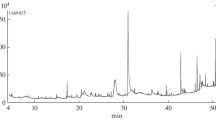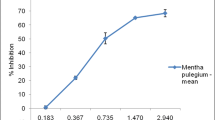Abstract
In this work, the chemical composition, the antioxidant, and the antibacterial activities of two Moroccan essential oils less studied, extracted from Pelargonium asperum and Ormenis mixta, were investigated. According to the gas chromatography coupled to mass spectrometry analysis, citronellol (25.07%), citronellyl ester (10.52%), geraniol (10.46%), and buthyl anthranilate (5.93%) were found to be the major components of P. asperum, while O. mixta was mainly composed of D-germacrene (11.46%), 1,8-cineole (10.28%), and cis-methyl isoeugenol (9.04%). Moreover, O. mixta essential oil exhibited an important antioxidant activity being significantly higher than that exhibited by P. asperum oil (P < 0.001). As regards the antimicrobial activity of both essential oils, the zones of growth inhibition and the minimum inhibitory concentration values showed that P. asperum essential oil was more active than that of O. mixta. Thereafter, the impact of the binary combination of essential oils on their antimicrobial effect was investigated against Staphylococcus aureus using the fractional inhibitory concentration index calculation. The results showed a promising synergistic antibacterial interaction between essential oils studied.
Similar content being viewed by others
References
Aazza S, Lyoussi B, Miguel MG (2011) Antioxidant and antiacetylcholinesterase activities of some commercial essential oils and their major compounds. Molecules 16:7672–7690. doi:10.3390/molecules16097672
Adams RP (2007) Identification of essential oil components by gas chromatography/mass spectrometry, 4th edn. Allured Publishing Corporation, Carol Stream, p 804
Adelakun OE, Oyelade OJ, Olanipekun BF (2016) Essential oils in food preservation, flavor and safety, essential oils in food preservation, flavor and safety. Elsevier, London. doi:10.1016/B978-0-12-416641-7.00007-9
Avila-Sosa R, Palou E, López-Malo A (2016) Essential oils added to edible films. In: Preedy VR (ed) Essential oils in food preservation, Flavor and Safety. Elsevier, London, pp 149–154. doi:10.1016/B978-0-12-416641-7.00015-8
Bassolé IHN, Juliani HR (2012) Essential oils in combination and their antimicrobial properties. Molecules 17:3989–4006. doi:10.3390/molecules17043989
Bassolé IHN, Lamien-Meda A, Bayala B, Tirogo S, Franz C, Novak J, Nebié RC, Dicko MH (2010) Composition and antimicrobial activities of Lippia multiflora Moldenke, Mentha x piperita L and Ocimum basilicum L essential oils and their major monoterpene alcohols alone and in combination. Molecules 15:7825–7839. doi:10.3390/molecules15117825
Belhattab R, Amor L, Barroso JG, Pedro LG, Cristina Figueiredo A (2012) Essential oil from Artemisia herba-alba Asso grown wild in Algeria: variability assessment and comparison with an updated literature survey. Arab J Chem 7:243–251. doi:10.1016/j.arabjc.2012.04.042
Burt S (2004) Essential oils: their antibacterial properties and potential applications in foods—a review. Int J Food Microbiol 94:223–253. doi:10.1016/j.ijfoodmicro.2004.03.022
Chivandi E, Dangarembizi R, Nyakudya TT, Erlwanger KH (2016) Use of essential oils as a preservative of meat. In: Preedy VR (ed) Essential oils in food preservation, Flavor and Safety. Elsevier, London, pp 85–91. doi:10.1016/B978-0-12-416641-7.00008-0
Clinical and Laboratory Standards Institute (CLSI), 2012. Performance Standards for Antimicrobial Disk Susceptibility Tests; Approved Standard—Eleventh Edition. Pennsylvania 19087 USA
De Bellis P, Minervini F, Di Biase M, Valerio F, Lavermicocca P, Sisto A (2015) Toxigenic potential and heat survival of spore-forming bacteria isolated from bread and ingredients. Int J Food Microbiol 197:30–39. doi:10.1016/j.ijfoodmicro.2014.12.017
Deba F, Xuan TD, Yasuda M, Tawata S (2008) Chemical composition and antioxidant, antibacterial and antifungal activities of the essential oils from Bidens pilosa Linn. var. Radiata. Food Control 19:346–352. doi:10.1016/j.foodcont.2007.04.011
Doménech E, Jimenez-Belenguer A, Amoros JA, Ferrus MA, Escriche I (2015) Prevalence and antimicrobial resistance of Listeria monocytogenes and Salmonella strains isolated in ready-to-eat foods in Eastern Spain. Food Control 47:120–125. doi:10.1016/j.foodcont.2014.06.043
Elouaddari A, El Amrani A, Eddine JJ, Correia AID, Barroso JG, Pedro LG, Figueiredo AC, Cristina Figueiredo A (2013) Yield and chemical composition of the essential oil of Moroccan chamomile [Cladanthus mixtus (L.) Chevall.] growing wild at different sites in Morocco. Flavour Fragr J 28:360–366. doi:10.1002/ffj.3146
Fennane M, IBN Tattou M (2012) Statistiques et commentaires sur l ‘inventaire actuel de la flore vasculaire du Maroc. Bull l’Instit Sci Rabat Sect Sci Vie 34:1–9
Gallucci MN, Oliva M, Casero C, Dambolena J, Luna A, Zygadlo J (2009) Antimicrobial combined action of terpenes against the food-borne microorganisms Escherichia coli, Staphylococcus aureus and Bacillus cereus. Flavour Fragr J 24:348–354. doi:10.1002/ffj
Gutierrez J, Barry-Ryan C, Bourke P (2008) The antimicrobial efficacy of plant essential oil combinations and interactions with food ingredients. Int J Food Microbiol 124:91–97. doi:10.1016/j.ijfoodmicro.2008.02.028
Haba E, Bouhdid S, Torrego-Solana N, Marqués AM, Espuny MJ, García-Celma MJ, Manresa A (2014) Rhamnolipids as emulsifying agents for essential oil formulations: antimicrobial effect against Candida albicans and methicillin-resistant Staphylococcus aureus. Int J Pharm 476:134–141. doi:10.1016/j.ijpharm.2014.09.039
Höferl M, Stoilova I, Schmidt E, Wanner J, Jirovetz L, Trifonova D, Krastev L, Krastanov A (2014) Chemical composition and antioxidant properties of Juniper berry (Juniperus communis L.) essential oil. Action of the essential oil on the antioxidant protection of Saccharomyces cerevisiae model organism. Antioxidants 3:81–98. doi:10.3390/antiox3010081
Hsouna AB, Halima NB, Abdelkafi S, Hamdi N (2013) Essential oil from Artemisia phaeolepis: chemical composition and antimicrobial activities. J Oleo Sci 980:973–980
Johnson DR, Decker E a (2014) The role of oxygen in lipid oxidation reactions: a review. Annu Rev Food Sci Technol 6:8.1–8.20. doi:10.1146/annurev-food-022814-015532
Kahl R, Kappus H (1993) Toxicology of the synthetic antioxidants BHA and BHT in comparison with the natural antioxidant vitamin E. Z Lebensm Unters Forsch 196:329–338
Martin SJ, Pendland SL, Chen C, Schreckenberger P, Danziger LH (1996) In vitro synergy testing of macrolide-quinolone combinations against 41 clinical isolates of Legionella. Antimicrob Agents Chemother 40:1419–1421
Mighri H, Hajlaoui H, Akrout A, Najjaa H, Neffati M (2010) Antimicrobial and antioxidant activities of Artemisia herba-alba essential oil cultivated in Tunisian arid zone. C R Chim 13:380–386. doi:10.1016/j.crci.2009.09.008
Oroojalian F, Kasra-Kermanshahi R, Azizi M, Bassami MR (2010) Phytochemical composition of the essential oils from three Apiaceae species and their antibacterial effects on food-borne pathogens. Food Chem 120:765–770. doi:10.1016/j.foodchem.2009.11.008
Rana IS, Rana AS, Rajak CR (2011) Evaluation of antifungal activity in essential oil of Syzygium aromaticum (L)by extraction, purification and analysis of its main component eugenol. Braz J Microbiol 42:1269–1277
Regnault-roger C (2013) Essential oils in insect control. In: Ramawat KG, Mérillon J-M (eds) Natural products. Springer, Berlin, pp 4087–4107. doi:10.1007/978-3-642-22144-6
Riva A, Borghi E, Cirasola D, Colmegna S, Borgo F, Amato E, Pontello MM, Morace G (2015) Methicillin-resistant Staphylococcus aureus in raw milk: prevalence, SCCmec typing, enterotoxin characterization, and antimicrobial resistance patterns. J Food Prot 78:1142–1146. doi:10.4315/0362-028X.JFP-14-531
Santiesteban-López A, Palou E, López-Malo A (2007) Susceptibility of food-borne bacteria to binary combinations of antimicrobials at selected a(w) and pH. J Appl Microbiol 102:486–497. doi:10.1111/j.1365-2672.2006.03092.x
Satrani B, Ghanmi M, Farah A, Aafi A, Fougrach H, Bourkhiss B, Bousta D, Talbi M (2007) Composition chimique et activité antimicrobienne de l’huile enssentielle de Cladanthus mixtus. Bull Soc Pharmacol 146:85–96
Selim S (2011) Antimicrobial activity of essential oils against vancomycin-resistant Enterococci (vre) and Eschirichia coli O157:H7 feta soft cheese and minced beef meat. Braz J Microbiol 42:187–196
Sökmen A, Sökmen M, Daferera D, Polissiou M, Candan F, Unlü M, Akpulat HA (2004) The in vitro antioxidant and antimicrobial activities of the essential oil and methanol extracts of Achillea biebersteini Afan. (Asteraceae). Phytother Res 18:451–456. doi:10.1002/ptr.1438
Tisserand R, Young R 2014 13- Essential oil profiles. In: Tisserand R, Young R (eds) Essential Oil Safety. Elsevier, pp. 183–482. doi:10.1016/B978-0-443-06241-4.00013-8
Ultee A, Slump A, Steging G, Smid EJ (2000) Antimicrobial activity of carvacrol toward Bacillus cereus on rice. J Food Prot 63:620–624
Ultee A, Bennik MHJ, Moezelaar R (2002) The phenolic hydroxyl group of carvacrol is essential for action against the food-borne pathogen Bacillus cereus. Appl Environ Microbiol 68:1561–1568. doi:10.1128/AEM.68.4.1561-1568.2002
Wang W, Li N, Luo M, Zu Y, Efferth T (2012) Antibacterial activity and anticancer activity of Rosmarinus officinalis L. essential oil compared to that of its main components. Molecules 17:2704–2713. doi:10.3390/molecules17032704
Acknowledgements
The authors declare that there is no conflict of interest with any financial organization regarding the material discussed in the manuscript.
Author information
Authors and Affiliations
Corresponding author
Additional information
Responsible editor: Philippe Garrigues
Rights and permissions
About this article
Cite this article
Ouedrhiri, W., Balouiri, M., Bouhdid, S. et al. Antioxidant and antibacterial activities of Pelargonium asperum and Ormenis mixta essential oils and their synergistic antibacterial effect. Environ Sci Pollut Res 25, 29860–29867 (2018). https://doi.org/10.1007/s11356-017-9739-1
Received:
Accepted:
Published:
Issue Date:
DOI: https://doi.org/10.1007/s11356-017-9739-1




